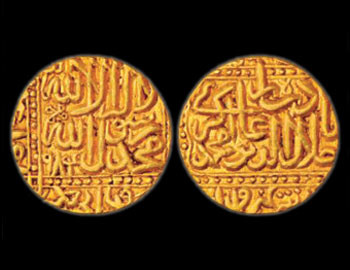

Akbar was the third ruler of the Mughal Dynasty in India from 1556 to 1605. He succeeded Humayun and went on to become one the greatest Mughal Emperors to conquer almost the entire Indian Subcontinent north of the Godavari river. Coins of Akbar also reflect the power of this mighty emperor. He was the one who made his mark with the help of Mughal military apart from political, cultural, and economic reforms that he introduced. His religiously and culturally diverse policies helped him gain support of the non-muslim sections of the society. He was the one who revolutionised Mughal style arts, painting, and architecture. Akbar preached about Din-i-Ilahi, a beautiful amalgamation of Islam, Hinduism, Zoroastrianism, and Christianity. He trusted his subjects, irrespective of their caste or religion and offered them important positions in the administrative and military setups. He got rid of the sectarian and celebrated all kinds of festivals.
Gold, silver and copper coins issued during the reign of Akbar followed the designs and patterns of Suri coinage. Gold coins of Akbar are known as ‘muhar’ and coins of varied denominations were minted. Initially heavy weight coins were more common which was slowly taken over by light weight ones. Fractional coins came into existence after 988 A.H, though they were rarely issued after that point in time. They were issued for the entire empire. Apart from that, some gold and silver coins of Akbar were issued with a local pattern.
Gold coins of Akbar were like the ones issued during the reign of Humayun. Silver coins were issued from Gujarat, Malwa and Kashmir. Both square and round shaped coins were issued at the same time from 993 A.H. to 998 A.H. After that, square coins were pulled off from circulation slowly. Some commemorative gold coins of Akbar were also issued in Mihrabi shape i.e. hexagonal with oblong upper and lower sides and dome-shaped left and right sides. The coins of Akbar were known for their unique style, shape, and inscriptions. ‘Kalima’ type gold and silver coins were issued till 1585 A.D which followed the ‘Shahrukhi’ coins of Babur and Humayun. ‘Kalima’ with the names of four Khalifas were depicted on the obverse.
Akbar got rid of the ‘Kalima’ from coinage which reflected his outlook towards acceptance of all religions. Kalima was replaced by Ilahi creed Allah Akbar Jalla jalalah. The name and titles of the emperor were also withdrawn. Four kinds of Ilahi coins of Akbar were issued after 1585 A.D. The first one depicted just the Ilahi creed with Allah Akbar inscription on one side and Jalla jalalah on the reverse. These coins were issued in the 13th year of the reign of Akbar. The second type had the year inscribed with the word Ilahi on the Jalla jalalah side. Third type had the Ilahi creed one side and the dates in two lines on the other side. The coins bore the names of the month of issue which was an innovative step by Akbar. The mint name was also reintroduced in these coins.
Metrical legends were introduced by Akbar on some of his gold and silver coins, a tradition which was continued by most of his successors. Akbar Coins with Couplets were also introduced for the first time. Gold coins of Agra mint had metrical legends and silver coins from Allahabad issues had them as well. Akbar also reintroduced the pictorial motifs on some of his coins. After the conquest of fort Asirgarh, commemorative gold coins of Akbar was issued featuring a hawk on one side and the mint name and the date on the other side of the coin. Silver coins with Akbar riding a horse and a hawk were also issued. In later years, coins with effigy of Ram and Sita with the words ‘Rama Siya’ in Nagari were also released.
During the 44th year of his regime, Akbar issued copper coins or ‘dam’ which was one fortieth of a silver rupee. ‘nisfi’ or ‘adhelah’ (half), ‘paula’ or ‘rabi’ or ‘damra’ (quarter) and ‘damri’ (one eighth) were the fractional issues. ‘tankah’ was twice the weight of the ‘dam’ (664 grains). This is why these coins of Akbar are also known as ‘nim tankha’ or half tankah. Another series of copper coins were issued from Ahmedabad, Agra, Delhi and from some places outside India known as ‘tanki’. Akbar majorly followed the copper coinage of Babur and Humayun in respect of the legends. The difference was that Ilahi month and year was inscribed at a later stage. The obverse of the ‘tankah’ and ‘tanki’ coins had the value inscribed along with ‘Akbar Shahi’. The mint name was placed on the reverse along with the date. Depicting mint names on coins gained significance after Akbar and became an important part of Mughal coinage.
With the expansion of the mughal territory, several coins were issued with over forty five mints. Provincial capitals issued gold coins initially and then Delhi also started issuing them. Soon after that though, the mint at Delhi closed down and Ahemdabad took its position.
Mughal Coinage took a big leap in terms of originality and technicality like ornamentation of the background of the coin with floral scrollwork during the regime of Akbar.
Click here to explore in detail about coins of Akbar at Mintage World.
The Mintage World Team comprises of experts, researchers and writers from the field of Philately, Notaphily and Numismatics who try to shed light on some of the most interesting aspects of coins, banknotes and stamps from not just India but across the globe as well.